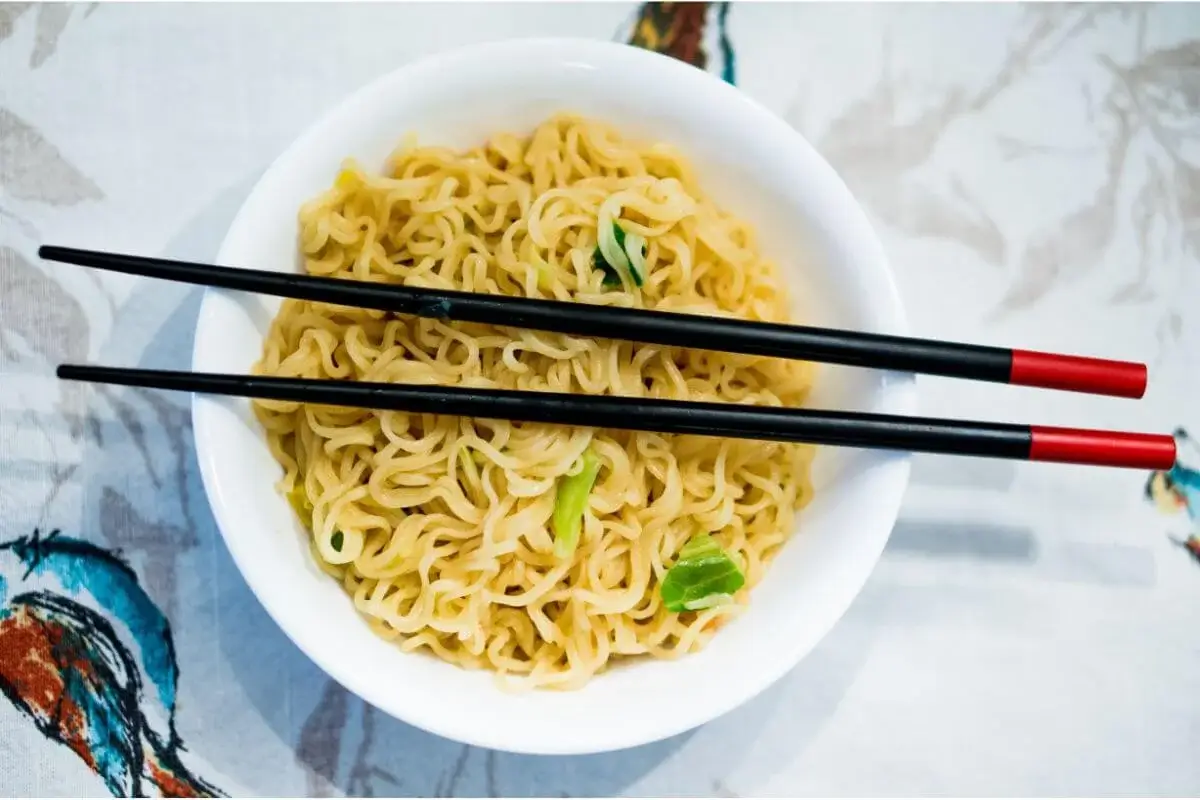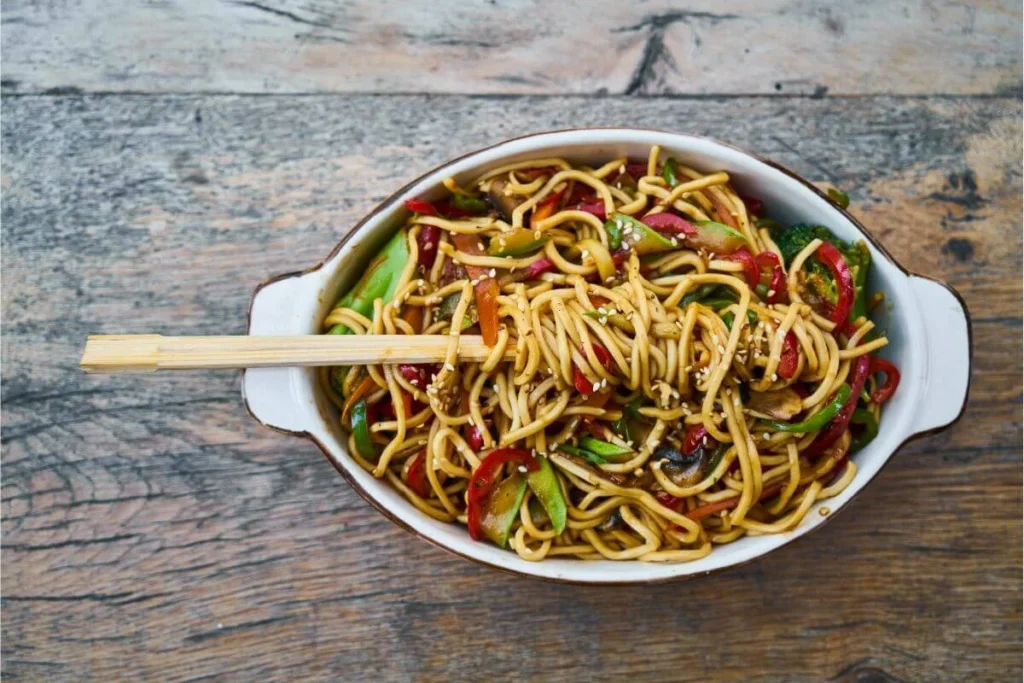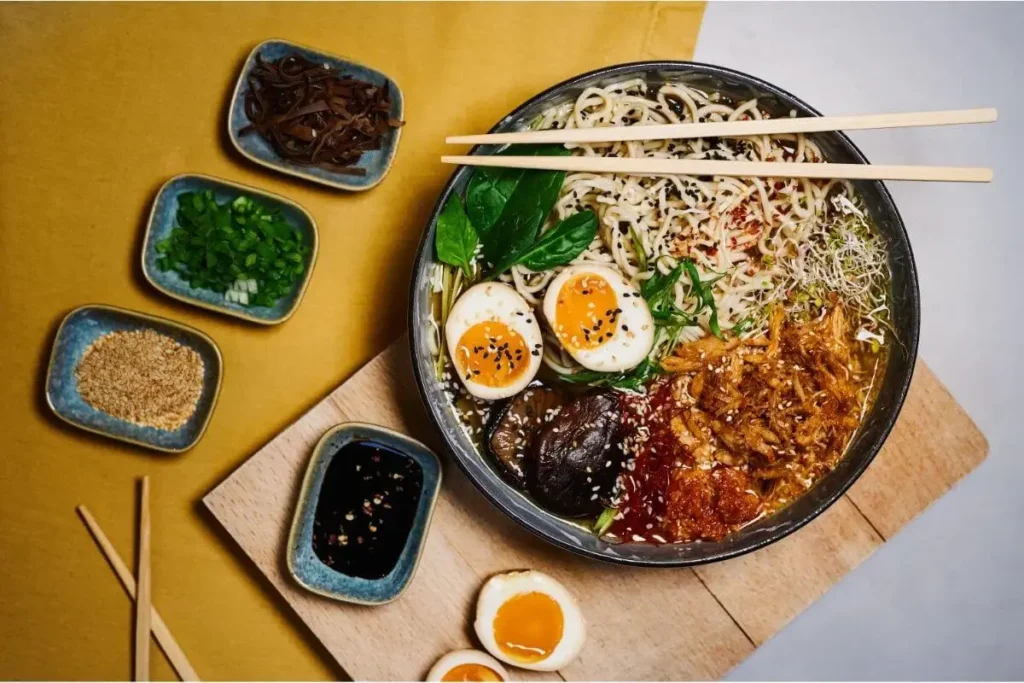Embark on a culinary journey with our comprehensive guide to making hibachi noodles recipe at home. This popular dish, a staple in Japanese cuisine, brings a touch of Asian flair to your kitchen with its unique blend of flavors and textures. Whether you’re a seasoned chef or new to the world of noodles, our guide is designed to walk you through every step, from selecting the right ingredients to perfecting your sauté technique. So grab your wok, and let’s dive into the delicious world of hibachi noodles!
Introduction to Hibachi Noodles Recipe
Hibachi noodles are more than just a dish; they’re an experience. Originating from the bustling street food scene in Japan, these noodles have gained immense popularity worldwide, known for their distinctive savory flavor and tantalizing aroma. Prepared on a large iron griddle, traditionally known as a ‘teppan,’ hibachi noodles are a highlight in Japanese restaurants, especially those featuring a dramatic, interactive cooking style.
Hibachi Noodles: A Cultural Staple
In Japan, hibachi-style cooking is revered not only for the delicious meals it produces but also for the artistry and skill of the chefs who prepare them. The term “hibachi” actually refers to a heating device, which is used in traditional Japanese homes. However, in the Western world, hibachi has become synonymous with teppanyaki cooking, where chefs prepare meals on an open grill, showcasing their culinary skills.
This cooking style emphasizes fresh ingredients and simple yet robust flavors, making hibachi noodles recipe a beloved choice for both their taste and theatrical presentation. The typical recipe includes noodles tossed with soy sauce, often enhanced with butter, garlic, and a medley of vegetables, making it a versatile dish that can be enjoyed on its own or as an element of a broader meal.
Making Hibachi Noodles Recipe at Home
With a few key ingredients and some basic equipment, you can recreate the magic of hibachi-style noodles in your own kitchen. The secret lies in the combination of flavors and the technique of cooking over high heat. This ensures that the noodles not only absorb the sauce effectively but also acquire a slightly crisp texture that is highly characteristic of the dish.
In the following sections, we’ll explore the essential ingredients needed to bring this dish to life, along with step-by-step cooking instructions and tips for achieving that authentic hibachi flavor. Whether you’re cooking for a family dinner or a special occasion, hibachi noodles offer a delightful blend of taste and tradition, ensuring a memorable dining experience.
Stay tuned as we delve into the world of ingredients and substitutions in the next part, ensuring that every reader can tailor their hibachi noodle adventure to meet their dietary needs and flavor preferences.
Ingredients and Substitutes
In creating the perfect hibachi noodles, the choice of ingredients plays a pivotal role. Let’s break down what you’ll need and explore suitable substitutes to accommodate various dietary preferences and ensure everyone can enjoy this delightful dish.
Essential Ingredients for Hibachi Noodles Recipe
At the heart of hibachi noodles are the noodles themselves, typically a type of wheat-based noodle like linguine or soba. These are sautéed in a savory mixture that forms the soul of the dish:
- Noodles/Pasta of your choice: Linguine works well, but for a more authentic touch, soba or udon can be excellent choices.
- Butter: Essential for that rich, glossy finish, but can be substituted with margarine or a vegan butter alternative for those avoiding dairy.
- Garlic: Minced, for a pungent kick that complements the sweetness of the sauces.
- Soy Sauce: Provides the umami backbone. Opt for low-sodium varieties if watching salt intake.
- Teriyaki Sauce: Adds a sweet and tangy flavor, though you can make a homemade version using soy sauce, a touch of honey, and some spices to control the sweetness.
- Sugar: Just a bit to balance the saltiness, with alternatives like honey or agave for those preferring natural sweeteners.
- Sesame Oil: For a nutty finish, drizzle lightly before serving.
- Sesame Seeds: Optional, for garnish to add texture and visual appeal.
Noodle Varieties Suitable for Hibachi
Choosing the right type of noodle can significantly affect the final texture and flavor of your dish:
- Linguine: Readily available and easy to cook, this makes a convenient substitute.
- Soba: These buckwheat noodles bring a robust flavor suitable for those seeking a gluten-free option, provided they’re purely buckwheat.
- Udon: Thicker and chewier, udon noodles absorb flavors well, making them a satisfying alternative.
Substitution Tips
When substituting ingredients, consider the flavor profile and cooking properties. For instance, if using a lighter oil instead of butter, you may miss out on some richness but gain a lighter, healthier dish. Similarly, adjusting the type and amount of sweetener can help tailor the dish to your dietary needs without compromising on taste.
In the next section, we’ll cover the step-by-step process to cook these noodles to perfection, highlighting tips and techniques to master the hibachi style at home. Stay tuned for the next part, where the culinary magic happens!
Step-by-Step Cooking Instructions
Creating hibachi noodles recipe at home is an exciting culinary project. Here’s how you can achieve the authentic hibachi taste and texture in your own kitchen, step by step.
Preparing Your Ingredients
Before you begin, it’s crucial to have all your ingredients prepped and ready to go. This includes cooking your noodles al dente, mincing the garlic, and measuring out your sauces and seasonings. Hibachi cooking is fast-paced, so having everything at hand will help you manage the process smoothly.
Cooking Techniques for Perfect Hibachi Noodles Recipe
- Heat Your Skillet or Wok: Start by heating a large wok or skillet over medium-high heat. The key to hibachi cooking is high heat, which helps to sear the ingredients quickly, locking in flavors.
- Sauté the Garlic: Add butter to the hot pan, followed by the minced garlic. Sauté for about 30 seconds or until fragrant. Be careful not to burn the garlic, as it can impart a bitter taste to the dish.
- Toss in the Noodles: Add your pre-cooked noodles to the skillet. Quickly toss them in the hot butter and garlic to start the flavor infusion.
- Add Sauces and Seasonings: Sprinkle sugar over the noodles, then pour in the soy sauce and teriyaki sauce. Mix all components thoroughly to achieve uniform coverage on the noodles. This combination creates the signature glossy and savory coating that hibachi noodles are known for.
- Season to Taste: Adjust the flavors with a sprinkle of salt and pepper. This is also the perfect time to add a dash of sesame oil, which should be used sparingly due to its strong flavor.
- Final Touches: Continue to cook the noodles for a few minutes until they begin to get a slight char—this adds to the authentic hibachi experience. Just before removing from heat, sprinkle with sesame seeds if using.
Tips for Perfect Sauteing
- Keep It Moving: Hibachi cooking is active! Keep the ingredients moving in the pan to avoid burning and to ensure even cooking.
- High Heat: Maintain a high heat throughout cooking to replicate the hibachi style and to get that slight char on the noodles.
- Flavor Balancing: Hibachi is all about the balance of flavors—salty, sweet, and umami. Taste as you go and adjust your seasonings to find your perfect balance.
By following these steps, you can bring the vibrant and lively flavors of a Japanese steakhouse right into your dining room. Next, we’ll explore how to serve and pair your hibachi noodles to enhance your meal even further. Stay tuned for more delicious tips!
How to Serve Hibachi Noodles Recipe
Once you’ve mastered the art of cooking hibachi noodles recipe, the next step is presenting and pairing them to elevate your meal to restaurant-quality. Whether it’s a casual family dinner or a special occasion, the right accompaniments and presentation can make all the difference.
Presenting Your Noodles
Presentation plays a big part in the hibachi experience. Here’s how to serve your noodles to impress:
- Plating: Serve the noodles on a large platter or individual plates. Hibachi noodles are typically heaped in a mound that showcases their glossy, saucy coating.
- Garnishes: Sprinkle with additional sesame seeds and perhaps some finely sliced green onions or a sprinkle of nori strips to add color and a touch of freshness.
- Accompaniments: Offer a side of extra soy sauce, some pickled ginger, or a dollop of sriracha or yum yum sauce for those who like an extra kick.
Pairing with Other Dishes
Hibachi noodles are versatile and can be paired with a variety of dishes:
- Protein Options: Serve alongside hibachi chicken, shrimp, or steak. These proteins can be cooked in the same style and with similar seasonings to complement the flavors of the noodles.
- Vegetables: Hibachi-style vegetables such as zucchini, onions, and mushrooms are a healthy and colorful side that pairs well with the noodles. Sauté these in the same pan to pick up any leftover sauce and seasonings for extra flavor.
- Rice: For those who prefer a variety of textures, a side of steamed or fried rice makes a great addition to a hibachi meal, making it more filling and balanced.
Enhancing the Meal Experience
To truly capture the spirit of a hibachi dinner, consider the overall dining experience:
- Interactive Cooking: If possible, prepare the noodles and accompanying dishes in front of your guests. This can recreate the engaging and interactive feel of a hibachi restaurant.
- Setting the Scene: Use chopsticks and serve the meal on Asian-inspired dinnerware. Background music featuring traditional Japanese instruments can enhance the ambiance.
With these tips, your hibachi noodles not only become a dish but a dining event that brings people together and creates lasting memories. Up next, we’ll tackle some frequently asked questions to help clear up any mysteries surrounding this beloved dish. Stay tuned for helpful insights and expert answers!
Related Hibachi Dishes
To create a full hibachi-style meal, consider pairing your hibachi noodles with other dishes that complement the flavors and enhance the overall dining experience. Here are some classic hibachi dishes to consider:
Hibachi Rice
A staple in any hibachi meal, this fried rice is cooked on the same grill as the noodles, allowing it to absorb all the delicious flavors from the previous dishes cooked on the teppan. It often includes eggs, vegetables, and sometimes bits of meat or seafood, seasoned lightly with soy sauce.
Hibachi Vegetables
Typically consisting of zucchini, onions, mushrooms, and sometimes carrots, cooks slice these vegetables and grill them to perfection alongside your main dishes. They season them with soy sauce and often a hint of butter, providing a smoky, savory side that balances the richness of the noodles and protein.
Hibachi Steak
For meat lovers, hibachi steak is a must. Choose a good quality cut like sirloin or ribeye, season simply with salt and pepper, and grill to your desired doneness. The high heat of the hibachi grill sears the steak beautifully, locking in flavors and juices.
Hibachi Chicken
Chicken is another popular protein option at hibachi restaurants. It’s typically marinated in a mixture of soy sauce, garlic, and perhaps a hint of ginger, then grilled to tender perfection. It’s a lighter option but no less flavorful.
Hibachi Shrimp
Quick to cook and delightfully flavorful, shrimp is a favorite for many. It’s often seasoned with just a little salt and maybe a squeeze of lemon juice after cooking, enhancing its natural sweetness.
Bringing It All Together
When serving a hibachi meal, timing is everything. Aim to have your sides and proteins ready to go as soon as the noodles are done to ensure everything is served hot. Arrange the dishes family-style on the table, allowing everyone to build their own perfect plate. This not only makes the meal more interactive but also allows guests to appreciate the variety of flavors and textures typical of a hibachi feast.
Up next, we’ll explore related hibachi dishes to help you round out your Japanese-inspired feast with complementary flavors and textures. Stay tuned for more tasty recipes and expert tips!
Frequently Asked Questions about Hibachi Noodles Recipe
When diving into the world of hibachi noodles, some common queries often arise. Let’s address these to enhance your understanding and confidence in cooking this delightful dish.
What kind of noodles are used in hibachi?
Traditionally, in a hibachi setting, you might see thin, wheat-based noodles similar to linguine or soba. These noodles are ideal because they hold up well to the high-heat cooking of the hibachi grill and absorb the flavors of the sauces beautifully.
What sauce is used in hibachi?
The sauce used in hibachi noodles recipe typically includes a combination of soy sauce and teriyaki sauce. This mixture provides a rich, umami flavor with a hint of sweetness, perfectly balancing the savory notes of the garlic and butter used in the dish.
What is the difference between yakisoba and hibachi noodles?
Yakisoba usually refers to a Japanese noodle dish cooked with a distinct sauce. This sauce includes Worcestershire sauce, soy sauce, and other seasonings, giving it a tangy and slightly sweet flavor. Hibachi noodles, on the other hand, focus on a cooking style. They use simple ingredients like soy sauce and butter, cooked under high heat to create a unique flavor profile.
What’s the difference between hibachi and lo mein?
Lo mein often focuses more on sauces and vegetables than on high-heat searing. Typically, cooks boil the noodles and then toss them in a thick sauce. Cooks quickly sear hibachi noodles on a high-heat grill (teppanyaki style). They get a light sauce coating that enhances, not overwhelms, their natural flavors and those of other fresh ingredients.
These FAQs clarify what sets hibachi noodles apart from other Asian noodle dishes. They also highlight the nuances that make them a favorite for many. With these questions answered, you now have better equipment to cook and enjoy hibachi noodles with a deeper understanding of their culinary context.
Next, we will wrap up with our final thoughts and encouragement for you to experiment with your new culinary skills. Stay tuned for the conclusion, where we’ll inspire you to take what you’ve learned and make it your own!
Final Thoughts about Hibachi Noodles Recipe
Congratulations on journeying through the delightful world of hibachi noodles and the various dishes that complement them! By now, you should have a solid foundation to not only recreate these recipes at home but also to experiment and personalize them to your taste.
Embrace Creativity in Your Cooking
Hibachi cooking is as much about the technique as it is about the specific ingredients. The high heat, the quick movement, and the simple yet flavorful components combine to create something truly special. Don’t be afraid to switch things up—try different noodles, experiment with sauces, or introduce new vegetables to your stir-fry.
Make It a Social Affair
One of the most enjoyable aspects of hibachi cooking is its inherent social nature. Additionally, consider setting up a small grill or cooking station where friends or family can gather around and watch as the meal comes together. This interactive experience not only creates a fun evening but also deepens the appreciation for the food served.
Keep Learning and Exploring
The world of Japanese cooking offers a vast array of techniques and flavors to explore. Furthermore, from mastering the perfect sushi roll to experimenting with different types of ramen, there is always something new to learn and enjoy. Use what you’ve learned making hibachi noodles as a stepping stone to further culinary adventures.
Conclusion
Cooking hibachi noodles at home is a rewarding experience that brings a taste of Japanese cuisine to your kitchen. Moreover, it’s a versatile dish, adaptable to various ingredients and preferences. Consequently, this makes it a favorite for both family meals and special occasions alike. So, take what you’ve learned, get creative, and most importantly, have fun with it! Every meal is an opportunity to create memories around the table.
Thank you for following along with this guide. Here’s to many delicious hibachi meals in your future!



